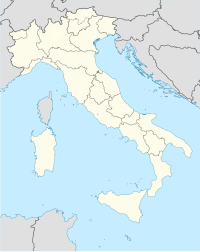Ponte Olivo Airfield
Ponte Olivo Airfield  | |
|---|---|
| Coordinates | 37°07′51.68″N14°19′17.27″E/ 37.1310222°N 14.3214639°E |
| Type | Military airfield |
| Site information | |
| Controlled by | United States Army Air Forces |
| Condition | Abandoned |
| Site history | |
| Built | Civil airfield prior to World War II |
| In use | 1920s?-1944 |
Ponte Olivo Airfieldis an abandoned pre-World War IIairport and later wartime military airfield inSicily,3 kilometres (1.9 mi) north ofGela.Its last known use was by theUnited States Army Air ForceTwelfth Air Forcein 1944 during theItalian Campaign.
History[edit]
Originally built asPonte Olivo Airportin the 1920s, the airport in September 1939 became base for the 41st Storm of the ItalianRegia Aeronauticawith 18Savoia-Marchetti SM.79that were later transferred (in October 1940) to the Italian bases roundBenghaziinCyrenaica.Together withComiso Airportit was extensively used for the bombing of theBritishbases on theMaltese islands.It was the primary objective of theAmphibious Battle of GeladuringOperation Husky.On 9 July 1943, theUnited States Army82d Airborne Division505th Regimental Combat Team and the 3d Battalion of the 504th Parachute Regiment was carried by 226C-47 Skytrainsof the61st, 313th, 314th and 316th Troop Carrier Groups,which departed fromKairouan Airfield,Tunisia.The parachutists mission was to seize the high ground near the airport and to assist the seaborne forces of U.S. II Corps, Seventh Army, in capture of the airfield. Although the parachute drops were widely scattered, the objective was taken. This was the first major airborne operation to be undertaken by Allied forces in World War II.[1]By morning, only 400 of the Regiment's 1600 soldiers had reached the objective area. The others had been dropped in isolated groups on all parts of the island and carried out demolitions, cut lines of communication, established island roadblocks, ambushed German and Italian motorized columns, and caused so much confusion over such an extensive area that initial German radio reports estimated the number of American parachutists dropped to be over ten times the actual number.

RenamedPonte Olivo AirfieldorGela Airfieldby the Americans, the USAAFTwelfth Air Force27th Fighter Bomber GrouplandedA-36 Apacheground support aircraft on the field as soon as it was declared secure for operations, supporting ground forces against the German and Italian forces.
The 27th moved toCapaccio Airfieldin southern Italy during September. Other units assigned to the airfield were:
- HQ,64th Fighter Wing,12 July – 1 September 1943
- HQ,51st Troop Carrier Wing,29 August – 29 September 1943
- 12th Bombardment Group,2–22 August 1943,B-25 Mitchell(9th AF)
- 86th Bombardment Group,21 July – 27 August 1943,A-36 Apache
- 31st Fighter Group,13–21 July 1943,Spitfire
- 60th Troop Carrier Group,31 August – 29 October 1943,C-47 Skytrain
- 62d Troop Carrier Group,6 September 1943 – February 1944,C-47 Skytrain
The USAAF closed its facilities at the airfield at the end of September 1944, and returned the airport to Italian authorities.
During the late 1950s and early 1960s it was reused as a private airport byEnrico Matteiand other managers of theEnte Nazionale Idrocarburi(ENI) for inspections on the nearbypetrochemical refineries.On 27 October 1962 at 07:30, Mattei took off fromPonte Olivo airportfor the last time with ENI's private plane, aMorane-Saulnier MS.760 Paris,not knowing he would die a few hours later in the skies of northern Italt when the plane exploded.
Today there are little or no remains of the airfield, with some faint land disturbances visible on aerial photography of its former runways. Some buildings in the area may have been reused and adapted for other purposes.
References[edit]
![]() This article incorporatespublic domain materialfrom theAir Force Historical Research Agency
This article incorporatespublic domain materialfrom theAir Force Historical Research Agency
- Maurer, Maurer.Air Force Combat Units of World War II.Maxwell AFB, Alabama: Office of Air Force History, 1983.ISBN0-89201-092-4.
- ^"Chronology, 1941–1945". Compiled by Mary H. Williams. United States Army in World War II: Special Studies. (Washington, D.C.:Office of the Chief of Military History,1960., Journal of American History, Volume 47, Issue 2, September 1960, p. 365,doi:10.2307/1891770


